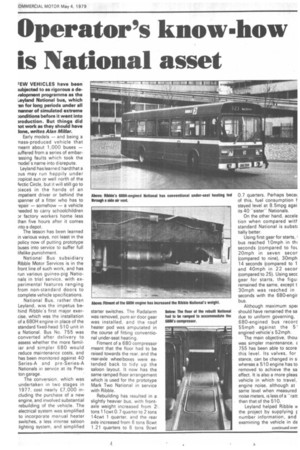Operator's know-how is National asset
Page 67

Page 68

If you've noticed an error in this article please click here to report it so we can fix it.
^EW VEHICLES have been mbjected to as rigorous a de felopment programme as the Leyland National bus, which an for long periods under all nanner of simulated extreme xmditions before it went into troduction. But things did tot work as they should have lone, writes Alan Millar.
Early models — and being a nass-produced vehicle that -neant about 1,000 buses ;uffered from a series of ember.assing faults which took the nodel's name into disrepute. Leyland has learned hardthat a )us may run happily under :ropical.sun or well north of the Nrctic Circle, but it will still go to oiecet in the hands of an mpatient driver or behind the Ipanner of a fitter who has to -epair — somehow — a vehicle leeded to carry schoolchildren Dr factory workers home less than five hours after it comes Into a depot.
The lesson has been learned in various ways, not least in the policy now of putting prototype buses into service to suffer full lifelike punishment.
National Bus subsidiary Ribble Motor Services is in the front line of such work, and has run various guinea-pig Nationals in trial service, with experimental features ranging from non-standard doors to complete vehicle specifications.
National Bus, rather than Leyland, was the impetus behind Ribble's first major exercise, which was the installation of a 680H engine in place of the standard fixed-head 510 unit in a National. Bus No. 755 was converted after delivery to assess whether the more familiar and simpler 680 would reduce maintenance costs, and has been monitored against 40 Series-A and pre-Series-A Nationals in service at its Preston garage.
The conversion, which was undertaken in two stages in '1977, cost nearly £7,000 including the purchase of a new engine, and involved substantial rebuilding of the vehicle. The electrical system was simplified to incorporate manual heater switches, a less intense saloon lighting system, and simplified starter switches. The Radalarm was removed, pure air door gear was installed, and the roof heater pod was amputated in the course of fitting conventional under-seat heating.
Fitment of a 680 compressor meant that the floor had to be raised towards the rear, and the rear-axle wheelboxes were extended back to tidy up the saloon layout. It now has the same ramped floor arrangement which is used for the prototype Mark Two National in service with Ribble.
Rebuilding has resulted in a slightly heavier bus, with frontaxle weight increased from 2 tons 11cwt 0.7 quarter to 2 tons 14cwt 1 quarter, and the rear axle increased from 6 tons 8cwt 1.21 quarters to 6 tons 9cwt 0.7 quarters. Perhaps becat of this, fuel consumption Istayed level at 8.5mpg agai its 40 ''sister" Nationals.
On the other hand, accele tion when compared witt standard National is substi tially better.
Using first gear for starts, bus reached 10mph in thi seconds (compared to tot, 20mph in seven secor (compared to nine), 30mph 14 seconds (compared to 1 and 40mph in 22 secor (compared to 25). Using sect gear for starts, the figul remained the same, except t 30mph was reached in seconds with the 680-engir bus.
Although maximum spel should have remained the sa due to uniform governing, 680-engined bus recorc 55mph against the 5' engined vehicle's 52mph.
The main objective, thou was simpler maintenance, E 755 has been able to score this level. Its valves, for stance, can be changed in s whereas a 510 engine has to removed to achieve the sa effect. It is also a more pleas vehicle in which to travel, engine noise, although at same level when measured noise meters, is less of a "ratt than that of the 510.
Leyland helped Ribble +.11 the project by supplying number information, and examining the vehicle in de after the project was completed.
Leyland helped also by flying certain parts back to Britain from Stockholm, where a batch of Panthers was the only fleet of Leylands running with power steering, compressor, and alternator driven directly off the engine.
Ribble notes with amusement that the prototype National 2 bears some resemblance to its own rebuild!
After 20 months' service experience with 755, 1978 Motor Show National 2 prototype 800 entered service in February from Chorley garage and has also been tested against standard vehicles. Its 8.3mpg fuel consumption is 0.2mpg better than that for 510-engined examples, but other factors are difficult to assess after such a short space of trial service.
It is something of a one-off vehicle, though, having a diff ratio lower than that selected normally by Ribble., and it has a Leyland 690H engine rather than the TL11H which will be used when National 2 goes into production. It also has a hydraulic fan drive fitted to a rear radiator, whereas the production model — and a second National 2 for Ribble — will have Economy spec front radiators.
, Both of these vehicles conform to Leyland's Series-B economy specification for the National, and Ribble has been involved also in the development of that vehicle. It placed a 10.3m Series-B prototype in service at its Southport garage in February last year, and has been running it mainly on a town service in Formby which demands a shorter vehicle.
Ribble's territory may not be the toughest in NBC's empire, but it does represent a fair measure of what a working bus must face, with routes running, from the gentle flat land on the Lancashire coast to the foothills of the Pennines. It is also the heartland of Leyland Vehicles, and having a bus on the factory doorstep is something which any manufacturer values.
Ribble's strong engineering tradition and Leyland's rapidly recovering faith in its customers' needs are ingredients in a story which should continue the success of not only National but Leyland buses in general.
























































































































